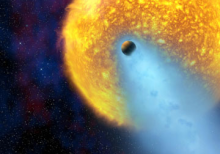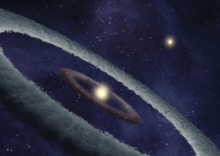RoPACS: Rocky Planets Around Cool Stars
A Marie Curie Initial Training Network
Age Constraining Companions to Exoplanet Host Stars
Information regarding this project is presented below
ESR/ER Researchers
UH ESR - Joana Gomes
Project Description
Searching for new age constraining companions to exoplanet host stars: New age constraints for known exoplanetary systems (as well as additional targets under close RV scrutiny that may yield planets in the future) will allow the evolution of exopalnetary systems to be studied to a level not previously possible. For example, the evaporation of hot Jupiter planets over time could cause such planets to shrink with age, eventually producing ancient rocky cores around very old exoplanet hosts. The effects of gravitational scattering over time could be important for moulding system architectures. The stability and evolution of exoplanets in inclined orbits could be studied as more inclinations are deduced. And the effects of giant planets on smaller planets in the same system could be revealed with evolutionary information. This project will search for age constraining wide companions to exoplanet host stars and targets of current and new RV searches. An important new source of age calibrating secondaries are WD stars, that can provide age constraints from their cooling age (which is a function of temperature and mass) particularly if the WDs are high mass (see Pinfield et al. 2006, MNRAS, 368, 1281). Very wide companions will not affect a planetary system directly, but can yield system ages by association (since components of a binary will have formed at the same time). Common proper motion and spectroscopic study will be used to identify wide companions. Evolutionary implications for exoplanet systems can then be assessed based on known system properties and the new age constraints for these systems.
 |
 |
 |
| Exoplanet system characteristics can evolve over time. For example, close-in giant planets known as Hot Jupiters (e.g. HD209458b) evaporate due to irradiation from the central star, and could become rocky cores after billions of years. Picture credit: ESA, Alfred Vidal-Madjar, and NASA. | The Dog Star Siris A and its faint white dwarf companion Sirius B. White dwarf companions can reveal the age of a multiple system, and any exoplanets therein. Picture credit: STScI. | This artist's conception shows a binary-star system (HD 113766), where it is suspected a rocky Earth-like planet is forming around one of the stars. Picture credit: NASA/JPL. |
Project Supervisors
UH - D. Pinfield, B. Burningham, H. Jones
Other Researchers Working on Project
A. Day-Jones, J. Jenkins, D. Weights